
White is probably the most problematic color (actually lack of pigment) in our breed. It is not the white coat itself that is unhealthy. White outside of the areas prescribed in the standard is a warning flag that there may be health problems related to lack of pigment or to homozygousity of the merle gene. White or excessively white Aussies can be produced by several mechanisms working singly or in combination. There is considerable visual overlap between homozygous merles and pattern whites. It's not always possible to be sure which a dog is without a DNA test for merle. As a generality, homozygous merles may have faded merling and lots of white, but in bloodlines where colors are typically dark and white markings are few, they may be dark with very little excess white. Among the defects commonly associated with excessive whiteness are deafness (full or partial in one or both ears) and vision problems and eye defects from mild to severe. There are several causes for whiteness, but the two most common are recessive pattern whites and the mating of two merles to produce a homozyous merle.
Albinism
True albino animals lack pigment in the hair, skin, and eyes. The eyes have a pinkish color and are quite light sensitive because they lack the shielding a pigmented iris would give them. Albinism in dogs is very rare, and it is not a significant cause of whiteness in Aussies.
Chinchilla White (cch)
This gene reduces pigment to near whiteness and is thought to be the gene responsible for dark eyed white German shepherd dogs. It is not known to occur in Aussies. Most or all purebred Aussies possess "C" at this locus.
Minus Modifiers
Minus modifiers act to remove pigment. White toes on Labradors and Dobes are often the result of minus modifiers acting on an otherwise self colored animal which lacks any white spotting genes. If a spotting pattern is present, such as the Irish spotting pattern in most collie breeds, any minus modifiers present will enhance its effect and may be responsible for collars and blazes exceeding their boundaries.

Jackson is a dog I rescued. He has a nice red merling pattern and his background color is the sugar/cinnamon type. His eyes have spectacular striations and appear in the eye color section. His tan points are very dark, and his head has no more than the usual amount of white. His collar exceeds his whithers by about 4 inches, and the white on his hind legs extends to the stifle. The white on his front legs extends upward to merge with his excessive collar. Jackson is a heterozygous merle with the Irish spotting pattern exaggerated by the effects of minus modifiers pulling out extra pigment. He would not properly be called a pattern white, as he shows no evidence of having a piebald spotting gene. He does have enough white to disqualify him from the conformation ring, though he has pigment where it counts most - around the eyes and around both ears.
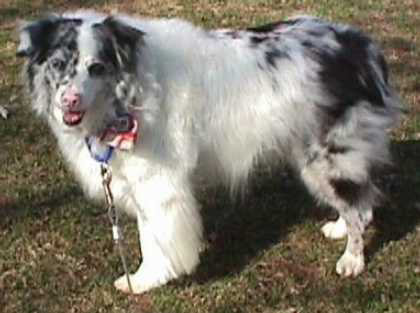
This handsome boy is another example of really enthusiastic minus modifiers, and possibly the piebald spotting gene (explained below). He exhibits the normal Irish spotting pattern, but look how far his white collar extends! A pinto (pattern white) might have even less white than this, but it would be arranged in irregular patches, not part of a clearly defined Irish spotting pattern. This might be just the step before color headed white.
Piebald Spotting Gene sp
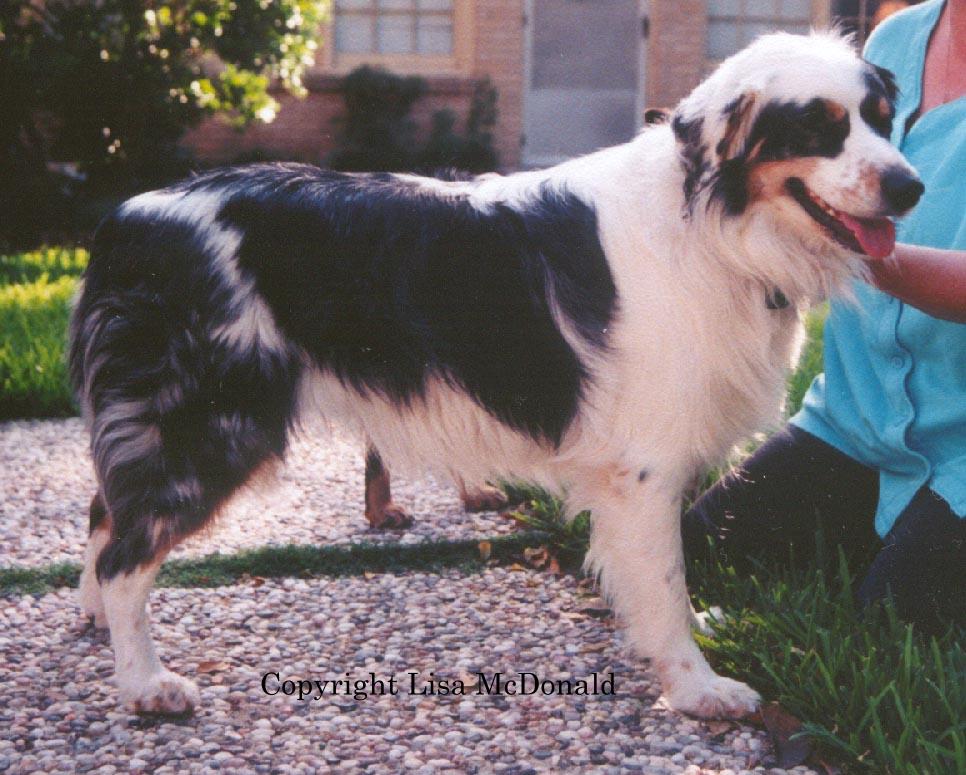
Riley is a blue merle who has the piebald spotting gene in addition to the Irish spotting pattern (s^i s^p). The Irish spotting pattern is a fairly symmetrical pattern of white. The piebald spotting gene is more irregular in location and appearance than the Irish spotting pattern. In him both patterns are visible, suggesting that dominance of s^i over s^p is not complete. The piebald spotting gene also occurs in solids and can be inherited as a recessive from two unmarked parents. It is not intrinsically unsound and is the norm in many breeds like the Foxhound. While it is a disqualified pattern, it is not problematic health wise unless it covers an ear. Riley does have substantial white on one ear, so it would be wise to check his hearing on that side.

This is Hannah, a pattern white black tri. Pattern white is not by any means restricted to merles. It can occur with any body color.
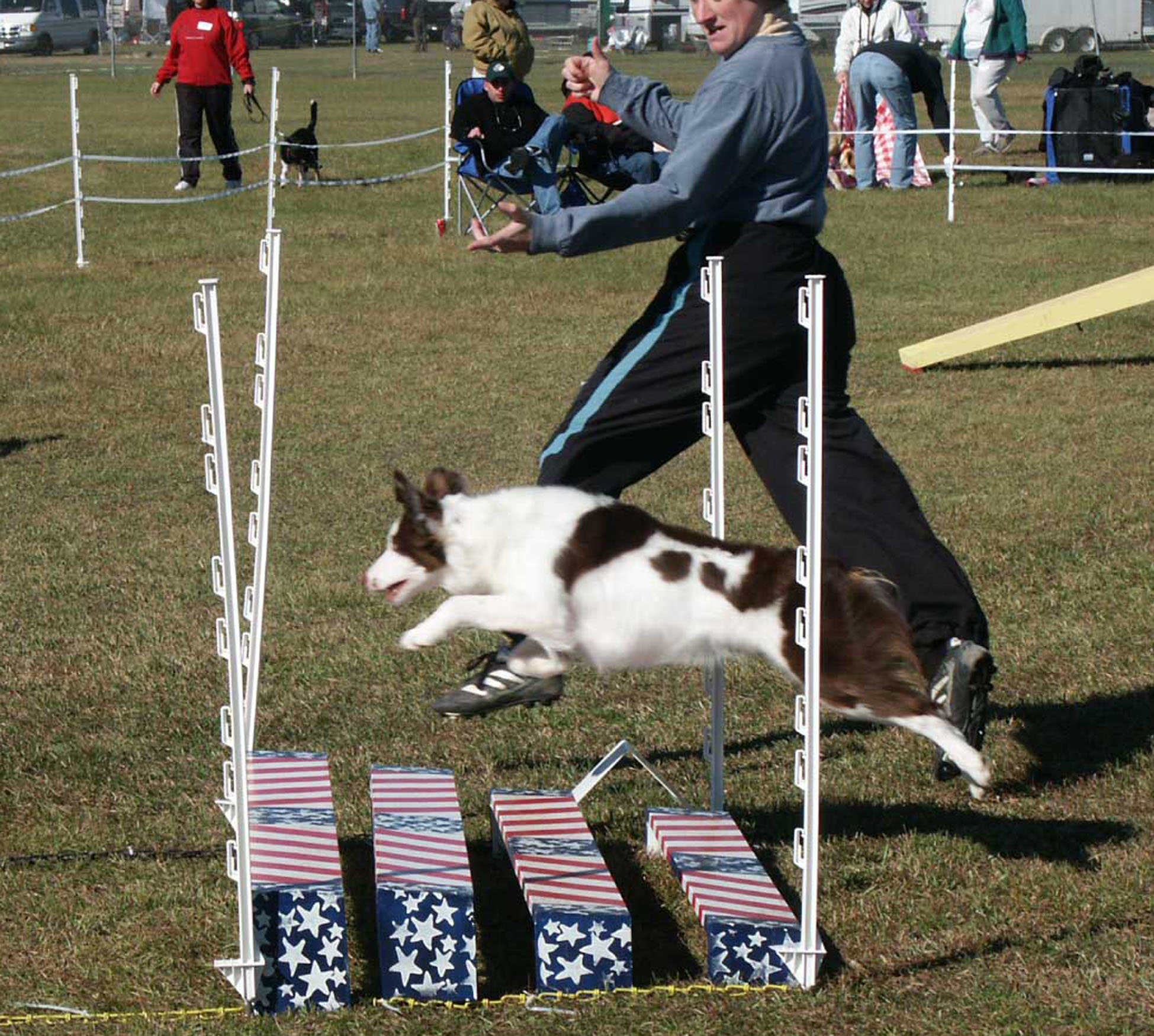
This spectacular red pinto, Darwin, is an enthusiastic agility competitor (photo courtesy Judith Lascola). He came from a litter of pintos of various colors, and his parents actually had only very modest amounts of white trim. He's healthy and sound in every way, because he has pigment where he needs it most - in the inner ear and in and around the eyes.
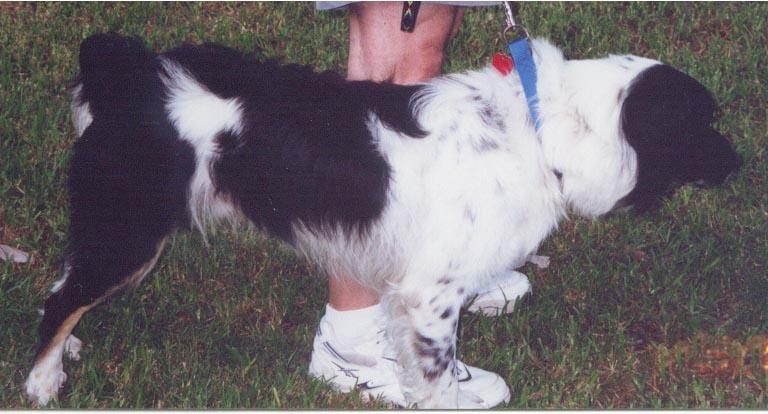
This is Zach, an adult black tri with the pinto pattern. He also has heavy ticking, especially on the legs and whithers. Because he also shows the Irish spotting pattern, his genotype is probably (atat B- DD kk Mm sisp). His head is nicely pigmented and his hearing is just fine. The left side of his head is white; he's a split face. However, the hair on the ear and around the eye on that side is black, a good sign when choosing a puppy for a pet that has more than allowable white.
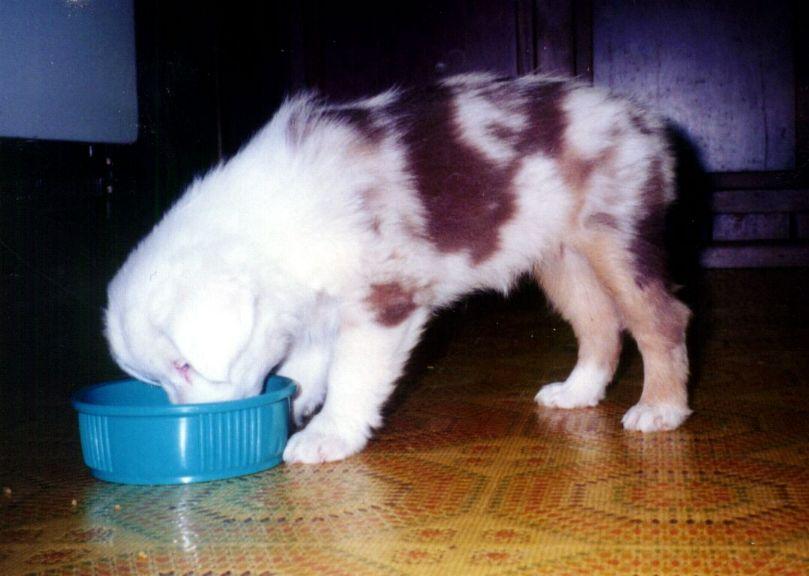
This is Joann Starks' puppy Cotton. She is a pattern white heterozygous red merle. One parent is a red tri and the other a red merle; both have very little white. But both are carriers of pattern white and produced a pattern white pup. Because she lacks pigment in the inner ears, she is totally deaf.
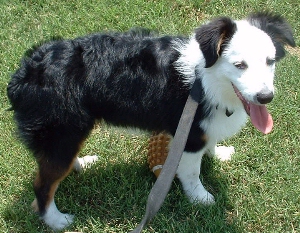
This is Hannah, a black tri girl whose markings remind one of a giant panda (photo courtesy Lori Fennell). Like Cotton she has a white head, but she also has fully pigmented ears and pigment around the eyes. She can hear just fine, and she is resistant to sunburn thanks to the pigmented skin around her eyes and on the top of her muzzle. If this is truly a form of pattern white it is a minimal expression of it. The gene(s) that causes white and half white heads is not fully understood.
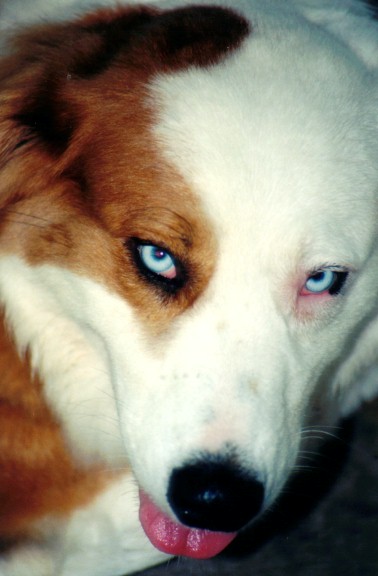
This is a closeup of Mack (photo courtesy of Tina Valant-Siebelts), an Aussie who also appears on the yellow page. He has a half white head, but note the location and amount of pigment on his exposed skin. He has heavy "mascara marks" around the eyes and a nice black nose. As a result, he does not sunburn like many white headed dogs do. That ring of pigment around the eyerims is very important UV protection.

Is this a pattern white? Technically, yes. He has a white spot on the back over his hips and another smaller white spot almost between his shoulder blades. But it is very common for pups born with such small white markings to lose them entirely by the time they are a year old. A potential buyer would need to be informed of this, because to produce pups with white in only the prescribed areas they'd need to choose mates for this dog that had no white spotting. He is also mentioned in the "difficult calls" section.
Extreme Pattern White sw
It is not known for sure whether extreme piebald spotting occurs in Aussies. It eliminates most pigmented areas and makes a white or almost all white dog (Pyrenes, Samoyed). If present, it might explain the rare cases in which an almost all white Aussie that is not of a merle to merle breeding has normal hearing and vision like a Pyr or Sammy. In these breeds the skin is usually pigmented even though the hair is not.

This is Emma, owned by Louise Gaynor, in a CKC (Canadian Kennel Club) obedience trial. Emma is a red pattern white Aussie and was photographed by Lisa Giroux. We do not know whether she is a red tri or red bi because the areas where tan points would normally appear are white. Louise reports that her hearing is normal and that she performs with enthusiasm in agility, obedience, and frisbee. These activities require sharp vision, which she has. She is also a therapy dog. With this degree of white she may actually be an extreme pattern white (sw).
Color headed white is a variation of the extreme pattern white in which the body of the dog is white. Only the dog's head and sometimes a small spot on the side or saddle have pigment. Modifying genes that determine the placement of the pigment are thought to have been fixed by selective breeding for dogs with pigmented heads. This is the required coloration in Papillions; the markings on the head are known as the "butterfly". In the Rough and Smooth varieties of the collie breed color headed white is allowed, but until recently the standard required a nonmerle head to avoid visual confusion with homozygous merles. In Border collies it is also seen occasionally. It has not been documented to exist in Aussies, but the following two specimens may be examples of color headed white. If the Elmo were not a merle it might be easier to positively ID him as such.
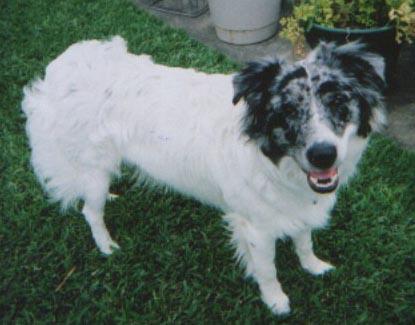
Does color headed white exist in Aussies as it does in Collies and Shelties? This is Elmo, a rescued Aussie. He may possibly be a color headed white. The pigment is centered and symmetrical on his head, and his blaze is actually quite modest in coverage. He also shows ticking on the body, legs, and muzzle. Because the colors of his parents are unknown, we can only speculate. If his head were black tri instead of blue merle, it would make an even stronger case for suggesting he is a color headed white. This is a case in which an experimental breeding to a nonmerle with very modest white could be enlightening.
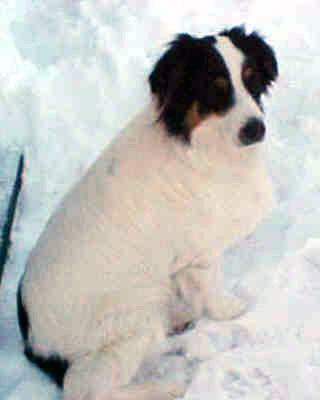
"Aussie" does not have enough pigment to determine whether he is merle at all (photo courtesy of Laura Lynn Tanner); the DNA test would be required to know this. He is the product of a merle to tricolor breeding, neither parent with excessive white. He is a black tri with a fully pigmented head and another patch of pigment on the rump. He has a littermate sister with similar coloring and a small patch on the saddle area. Color headed white? Could be.
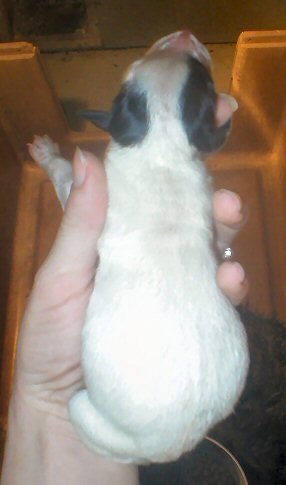
This newborn Aussie pup cropped up in a litter of pups with normal distribution of white markings. The pup is entirely white except for pigment on the ears and head. This might also be considered color headed white. As long as the pigment surrounds eyes and ears, there is a good probablility that hearing will be normal and eyerims will be dark enough to protect the skin from sunburn. We don't know yet if this pup will show ticking, since breeds with ticking (including the Aussie) are born with white areas clear of ticking. Ticking develops over a period of weeks and months.

This is a color headed white female puppy that cropped up in a litter of blue merles and black tris, photo courtesy of Lindsey Porter. The sire is a blue merle with white trim within acceptable limits and the dam is a black tri with even less white. There was another color headed white born in the same litter with a blue merle head, but for unknown reasons that puppy did not survive. Even dogs that have no hint of excess white themselves can carry the tendency recessively to produce extreme pattern whites like this one. But she has pigment where she needs it most: black nose leather, color around and on ears, and pigmented skin around the eyes.
Homozygous Merle (MM)
Homozygous merles are caused by the mating of two merles to each other. It does not matter whether the parents are both blues, both reds, or one of each. Statistically one can expect in a litter born to two merle parents: 25% solids, 50% normal heterozygous merles, and 25% homozygous merles. Homozygous merles may be faded in color, may have eccentric pupils or star burst pupils, and they often have white body splashes and white surrounding an eye or ear. In bloodlines where white markings are minimal and colors are rich, the homozygous merles may have very little white and not be faded in appearance. There is considerable visual overlap between piebald merles and homozygous merles. This is the reason that both are disallowed in the standard. The DNA merle test will determine whether a dog is a homozygous or heterozygous merle.

This is Shawna Graham's "Oink". He's a homozygous merle and is nearly all white. He is deaf, and his eyes are very pale. Oink fits the description of a typical homozygous merle pretty well, but not all homozygous merles are as white as Oink.
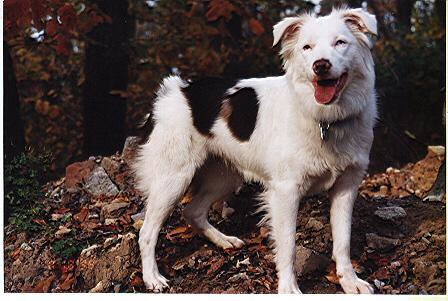
Lisa Pattison's "Chili" is a homozygous blue merle who has some pretty intense pigment in small areas of the body. She has a slightly bluish spot just below her tail nub and her ears have very faded merling. She is one very rare and lucky homozygous merle that has beaten the odds in terms of hearing and eye soundness. Very few Aussies with this degree of white have enough pigment in the inner ear to transmit sound properly.
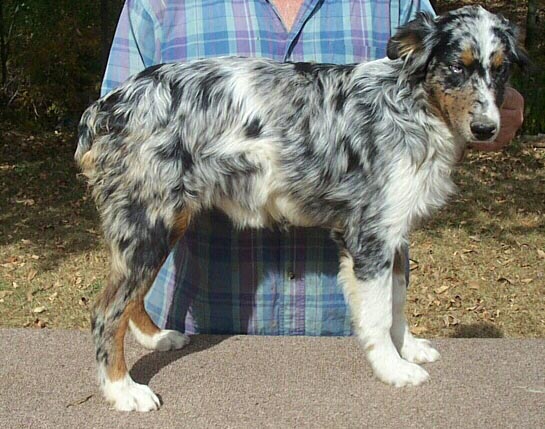
This puppy, Ronnie, is an example of a homozygous merle who shows very little excess white. He comes from a bloodline that is known for producing minimal to no white markings, and his parents have very minimal amounts of white themselves. Parents that are quite dark and have little to no white can produce homozygous merles that are much darker with much less white than is common for homozygous merles. The only obvious clue here that Ronnie is MM is that white stripe that extends up the side from his belly. The left side of his body displays even less white. But Ronnie shows sunburst pupils, and if mated to a black tri would produce only merles since he has only merle genes to give.

This is "Nikki", a very agile 12 year old Aussie (photo courtesy Lisa of Aerodahlin). She is one of those cases where you scratch your head and estimate what she is based on observation. She has the white distribution of either a homozygous merle or an extreme pattern white. The merling she does have is very dark without any tendency to fade. Her hearing and sight are normal, probably thanks to the dark pigment on and around the ears. This call could go either way. Here's where it would be very useful to see the parents and/or to perform the DNA test for merling.
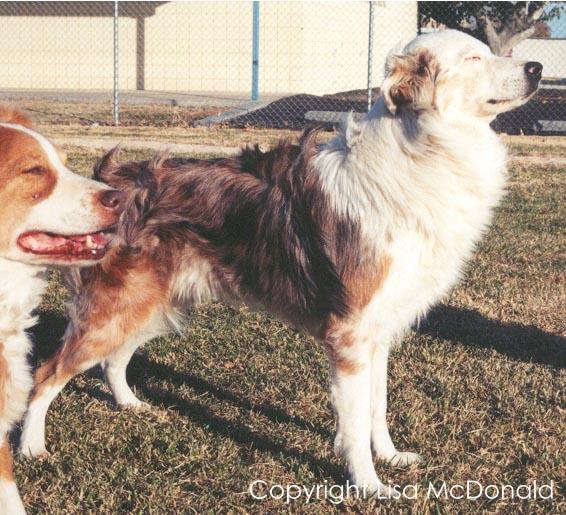
This is Regal, son of Scooter and owned by Lou McCammon. Regal is a sable homozygous merle. His body color is fairly intense, but he does show some fading of pigment on the face and on the upper foreleg. He has a slight degree of micropthalmia of the right eye. His left eye appears normal, and he leaps and catches the disks like his father (background) did when he was younger. Regal's probable genotype is (ayat Bb DD kk MM sisi).
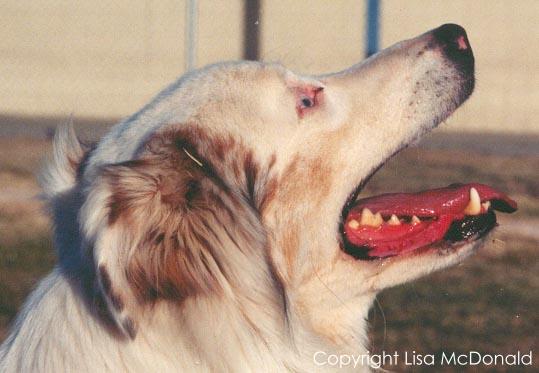
This is a closeup of Regal's face. His sable coloration is clearly faded on the cheeks, sides of the muzzle, and lower jaw. This fading of color is common in homozygous merles. Even though merling may be hard to see on a normal heterozygous sable merle, that pair of merle genes in a homozygous merle removes pigment from a sable just as it does from a more ordinary blue or red merle. An E locus yellow would be affected in a similar manner if two copies of the merle gene were present; the coverage of yellow would be reduced by their action. Regal has a very wide blaze, but he is fortunate in that his ears are pigmented. While the right eye is smaller than the left, his hearing appears to be normal by human standards and he is an avid disc grabber.
© 1999-2009 Lisa McDonald Comments